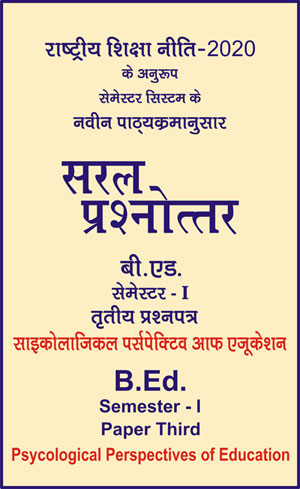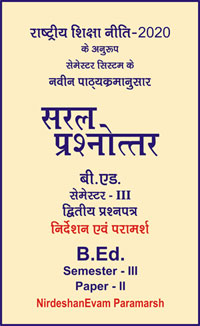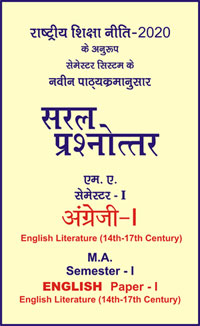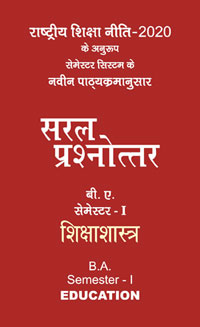|
बी एड - एम एड >> बी.एड. सेमेस्टर-1 प्रश्नपत्र-III - साइकोलाजिकल पर्सपेक्टिव आफ एजूकेशन बी.एड. सेमेस्टर-1 प्रश्नपत्र-III - साइकोलाजिकल पर्सपेक्टिव आफ एजूकेशनसरल प्रश्नोत्तर समूह
|
|
|||||||
बी.एड. सेमेस्टर-1 प्रश्नपत्र-III - साइकोलाजिकल पर्सपेक्टिव आफ एजूकेशन (अंग्रेजी भाषा में)
Question- Describe briefly various types of ‘Personality’.
Answer-
A large number of studies advocated the theory of type of personality by classifying human beings into more or less clear cut types based on their temperament, ways of behaviour, body build, mental make up or the objectives they pursued or aimed at in life.
First Type : The earliest attempt to classify human beings into types based on temperamental qualities caused by what were called “humours” or fluids in the body and its build, was of Hippocrates, the medical man in ancient Greece. He classified persons in four types as under :
(a) Sanguine : Who had more blood in the body, were said to be light-hearted, optimistic, happy, accommodating, hopeful, ardent and confident.
(b) Phlegmatic : Who had more colourless and thick phlegm as the dominant humour, were said to be cold, calm, slow or sluggish, indifferent, placid, not easily excited and rather dull.
(c) Choleric : Who had more yellow bile in their system and were said to be irritable, angry but were passionate and strong with active imagination.
(d) Melancholic : Who had more black bile as the dominant humour, were surly or bad-tempered, pessimistic, dejected, sad, depressed, pensive, deplorable, miserable and self-involved.
Second Type : Another classification into types based on bodily structure was given by Kretschmer who divided human being into the four types as under :
(a) Athletic : Who were strongly built with muscular body, wide chest and shoulders, large hands and feet.
(b) Asthenic : Who were lean, frail, flat-chested, weak or sick, lacking in strength with debility.
(c) Pyknic : Who were short limbed with large head, chest and abdomen. They had plump body, roundish and fatty, their face was soft and broad with broad hands and feet but they had slender neck and crooked nose, typical of a ‘devil’, as it were.
(d) Dysplastic : Who were rather lanky with ill-balanced and under developed body. They had underdeveloped secondary sex characteristics and were incompatible in sex relations.
Third Type : A similar classification based on bodily variations was given by W.H. Sheldon according to whom the types of persons were :
(a) Endomorphic or Viscerotonic : Who had big viscera, were flabby with weak bones and muscles but were fatty. They liked ease, comfort and support from others.
(b) Mesomorphic or Somatotonic : Who had strong muscles and bones but were slim. These persons were active, assertive, competitive and aggressing or struggling to achieve their goals.
(c) Ectomorphic or Cerebrotonic : Who were weak, frail and skinny. They were stiff, restrained, afraid, with lack of confidence. They had nervous and retiring nature and they suppressed their emotions and were sorrowful.
Fourth Type : Another classification was made by Kraeplin from the point of view of mental structure as under :
(a) Cycloids : Who were social, good natured, sentimental, emotional and rather restless. They were helpful, co-operative with feelings for others and friendly. They could develop mental symptoms of manic depressives.
(b) Schezoids : Who were self-centered, unsocial, hot-tempered, unsympathetic and eccentric but often intelligent and imaginative. They could develop symptoms of schizophrenia.
Fifth Type : A similar classification based on mental structure or in terms of the mental energy or libido flowing inwardly or outwardly was given by C.G. Jung who thought that there were four important functions in the individual through which libido expressed itself inwardly or outwardly. These functions were sensation, feelings, thinking and intuition and so there were really eight types of people :
(a) Introverted : In which category were introverted sensorial, introverted feeling, introverted thinking and introverted intuitive types of persons. Similarly, there were :
(b) Extroverted : Sensorial, feeling, thinking, and intuitive types of personality.
Sixth Type : Spranger made a classification of human beings on the basis of values they held dear and whose objectives in life were the pursuit of those values. This classification was according to the following six values :
(a) Economic : Those who aimed at economic gains or wealth.
(b) Social : Those who wanted to have social prestige or position, status or name and fame.
(c) Theoretical : Those who pursued studies and academic gains.
(d) Aesthetic : Who wanted to keep busy themselves in the pursuit of art creation and art appreciation.
(e) Political : Those who struggled for political power like-political leaders, statesman etc.
(f) Religious : Who pursued religious experience and devoted more time in religious practices, study and meditation.
Seventh Type : Adler made a classification of children, on the basis of the style of life they adopted by virtue of their ordinal position in the family and which style of life became the style even in adulthood for the sake of gaining power or position, as according to Adler, power seeking was the chief aim in life of everybody. He named the following four types :
(a) Demanding Type : Who dominate and demand from others and consider it their privilege. The eldest child, according to Adler, adopts this style of life.
(b) Escaping Type : Are the only children who are pampered and who are not taught how to struggle or face the difficulties. They escape the solution of problems and make excuses.
(c) Getting Type : Are the youngest children who, being everybody’s pet are given things easily. They are dependent, looking to others for help.
(d) Struggling Type : Are the other children in the family who know that unless they try on their own, they were not getting any help or advantage and so they struggle in later life also.
Eighth Type : Classification of human beings has been done by many other people also. Francis Galton, for example, categorised people as visulle, audile, olfactile, volatile and gustatile in accordance with their capacity to recall experiences or imagery pertaining to vision, hearing and sensations of touch, smell and taste respectively. William James also thought of tough-minded and soft-minded persons.
|
|||||

 i
i 










